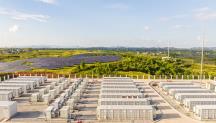

Electricity Storage: Technology Brief
Newsletter
Electricity storage is a key technology for electricity systems with a high share of renewables. Notably, storage allows electricity to be generated when variable renewable energy sources, namely wind and sunlight, are available, and then to be consumed on demand.
Electricity storage options are expected to become more widespread and cost effective as the share of renewables in the energy system rises. Yet storage remains technically challenging, because electricity can only be stored after conversion into other forms of energy, which requires expensive equipment and entails energy losses.
Pumped hydropower, whereby surplus electricity is used to pump water from a lower to an upper reservoir, has emerged as the first commercially viable electricity storage option. The stored energy can be used to produce hydropower during daily high-demand periods.
Other storage technologies at demonstration or pre-commercial stages include:
- Compressed air energy storage (CAES);
- Flywheels;
- Electrical batteries and vanadium redox flow cells;
- Supercapacitors;
- Superconducting magnetic storage;
- Thermal energy storage.
This brief focuses on three key aspects of electricity storage development:
- Process and Technology Status;
- Performance and Costs;
- Potential and Barriers.




